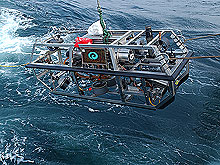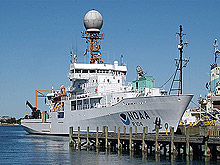
Off the deck of the NOAA ship Ronald H. Brown, about to decend 4000 meters to the Titanic shipwreck site. Click image for larger view. (HR)
Dwight F. Coleman
Director of Research
Institute for Exploration
Mystic Aquarium
Remotely Operated Vehicles (ROVs): An ROV is a un-manned underwater robot that is attached to a ship with a cable and then lowered underwater. The ROVis controlled by a pilot onboard the ship, and video cameras on the ROV allow scientists see objects underwater that would be too dangerous to reach by SCUBA diving.
Argus: Argus is a metal "towsled" that is attached to either Hercules or Little Herc. This towsled can record video footage in high-definition, and it offers additional light for the other ROVs. Argus hangs from the ship by a long cable and is moved by raising or lowering the cable. Thrusters, which are electric motors with propellers, on Argus enable the pilot to move the sled and also aim its lights and cameras towards interesting-looking objects.

Onboard the R/V Knorr in the Black Sea in 2003. Ready for launch to conduct artifact recoveries and test excavations from an ancient shipwreck. Engineer Todd Gregory completes a pre-dive check. Click image for larger view and image credit. (HR)
Hercules: Hercules is a large ROV and is the first undersea vehicle built primarily for deep-sea archaeological excavations. This ROV, however, also excels at other photographic survey missions. The ROV is moved by thrusters along each side and is attached to Argus with a cable that is about 100 feet long. Hercules is also equipped with a high-definition video camera, two manipulator arms, water jets, suction hoses, and sensors that record scientific information.
Little Herc: Little Herc (short for Little Hercules) is a small ROV that is mainly used to gather high-definition video footage of underwater objects. The camera attached to Little Herc provides as much detail as possible to observers aboard the ship. Like Hercules, this ROV is propelled by four thrusters, so it can move easily underwater. Little Herc's size also allows it to get close to specific objects or enter openings within shipwrecks.

NOAA Ship Ronald H. Brown in Woods Hole, 2004, immediately following the Titanic expedition. The satellite dish and control van can be seen on the forward 01 deck. Click image for larger view. (HR)
Research Vessel
Ronald H. Brown: The Ronald H. Brown is a ship that is operated by the National Oceanic and Atmospheric Administration (NOAA). This research vessel that is capable of supporting a large variety of underwater expeditions. The Ronald H. Brown, which has a length of 274 feet and a width of 52.5 feet, is one of America's most technologically advanced research ships. There are five primary laboratories onboard, and additional space on deck can fit up to nine laboratory vans. The ship is also equipped with many instruments that record scientific information, such as those that keep track of the weather or create maps of the ocean floor. The Ronald H. Brown can also remain stationary in the open ocean using its dynamic positioning system (DPS). DPS is essential when operating ROVs off of the ship.

View of the Imaging Van onboard the R/V Knorr in the Black Sea in 2003. Points of view from both Argus and Hercules as it retrieves and ancient amphora from a Roman period shipwreck. Click image for larger view and image credit. (HR)
Telepresence Capability
Seagoing Control Vans: The vehicle control vans are shipping containers that have been equipped with specific technologies for use by the operators of the remotely operated vehicle systems. The pilots, engineers, and scientists sit inside these containers to do their work on the seafloor using the robotic vehicles by remote control. The satellite control van sends all the video and data from the ship to shore, where people can view the expedition live without being onboard the ship.
Inner Space Center: The Inner Space Center was created for the University of Rhode Island's Institute for Archaeological Oceanography to present scientific andarchaeological information in real time. The Center is based on the model used by the NASA command center, so once video footage from the ROVs or the research vessel in the field are transmitted to a shipboard control center, they may then be directly broadcast to stations across the country. These stations provide students, teachers, and researchers with access to deep-sea archaeological or other oceanographic expeditions in real-time on a 24-hour basis. Therefore, the Inner Space Center enables researchers and students to directly participate in a field study without physically being on the research ship, so more individuals may play an active and helpful role during an expedition
Related Links

